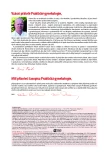Pelvic exenteration and female sexuality
Authors:
Petra Vrzáčková
Authors‘ workplace:
Gynekologicko-porodnická klinika, 1. LF UK a VFN, Praha, přednosta prof. MUDr. Alois Martan, DrSc.
Published in:
Prakt Gyn 2013; 17(4): 301-303
Category:
Gynecology and Obstetrics: Review Article
Overview
Pelvic exenteration is one of the most extensive oncogynaecologic procedure. Beside it´s significant morbidity and mortality, pelvic exenteration has in certain indications often no other therapeutic option. Procedure enables very good overall survival for women with recurrent gynacologic malignancies. Important factor for these patients is not only survival itself but also high quality of life including sexuality. Psychosexual counselling is therefore essential not only before operation but also during follow up.
Key words:
pelvic exenteration – psychosexual counselling – sexuality
Sources
1. Cibula D, Freitag P, Fischerová D et al. Exenterace pánve. Ceska Gynek 2005;70(1): 44–50.
2. Ferenschild FT, Vermaas M, Verhoef et al. Total pelvic exenteration for primary and recurrent malignancies. World J Surg 2009; 33(7): 1502–1508.
3. Cibula D, Petruželka L et al. Onkogynekologie. Grada Publishing: Praha 2009. ISBN 978–80–247–2665–6.
4. Løve US, Sjøgren P, Rasmussen P et al. Sexual dysfunction after colpectomy and vaginal reconstruction with a vertical rectus abdominis myocutaneous flap. Dis Colon Rectum 2013; 56(2): 186–190.
5. Avradopoulos KA, Vezeridis MP, Wanebo HJ. Pelvic exenteration for recurrent rectal cancer. Adv Surg. 1996; 29: 215–233.
6. Tanaka S, Nagase S, Kaiho-Sakuma M et al. Clinical outcome of pelvic exenteration in patients with advanced or recurrent uterine cervical cancer. Int J Clin Oncol 2013 [Epub ahead of print].
7. Marnitz S, Köhler C, Müller M et al. Indications for primary and secondary exenterations in patients with cervical cancer. Gynecol Oncol 2006;103(3): 1023–1030.
8. Schmidt AM, Imesch P, Fink D et al. Indications and lond-term clinical outcomes in 282 patients with pelvic exenteration for advanced or recurrent cervical cancer. Gynecol Oncol 2012;125(3):604–609.
9. Oranratanaphan S, Termrungruanglert W, Sirisabya N. Characteristics of gynecologic oncology patients in King Chulangkorn Memorial Hospital – complications and outcome of pelvic exenteration. Asian Pac J Cancer Prev 2013; 14(4): 2529–2532.
10. Rezk YA, Hurley KE, Carter J et al. A prospective study of quality of life in patients undergoing pelvic exenteration: interim results. Gynecol Oncol 2013;128(2): 191–197.
11. Soliman PT, Sun CC, Westin SN et al. Longitudinal quality of life (QOL) and sexual functioning in women undergoing pelvic exenteration for gynecologic malignancies. J Clin Oncol 2013;31(Suppl): Abstr 5608.
12. Roos EJ, de Graeff A, van Eijkeren MA et al. Quality of life after pelvic exenteration. Gynecol Oncol 2004; 93(3):610–614.
13. Hawighorst-Knapstein S, Fusshoeller C, Franz C et al. The impact of treatment for genital cancer on quality of life and body image – results of a prospective longitudinal 10-year study. Gynecol Oncol 2004; 94(2): 398–403.
14. Schönnefuss G, Hawighorst-Knapstein S, Trautmann K et al. [Body image in gynecologic patients before and after radical surgery]. Zentralbl Gynakol 2001;123(1): 23–26.
15. Turčan P, Pokorný P, Fait T et al. Sexuologie pro gynekology a urology. Maxdorf 2012. ISBN 978–80–7345–291–9.
Labels
Paediatric gynaecology Gynaecology and obstetrics Reproduction medicineArticle was published in
Practical Gynecology

2013 Issue 4
Most read in this issue
- Stillbirth – persistent problem of perinatal care
- Obstetrical anesthesia – Czech Republic versus world
- Principles and results of National register of assisted reproduction
- Traffic injuries of the pregnant women
